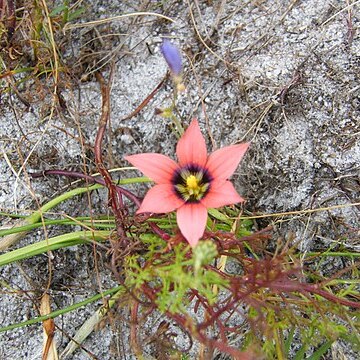Plants 60-300 mm long. Corm bell-shaped, with fine fibrils on a circular basal ridge. Stem short or up to 180 mm long. Basal leaves 2 or more, filiform or compressed cylindrical, 50-300 x 0.5-4 mm, glabrous or minutely ciliate on the rib margins, grooves narrow or wide. Bracts green, inner with wide or narrow, brown or colourless membranous margins. Flowers (15-)20-45 mm long, apricot-pink to dark old-rose or sometimes rosy-magenta, often with dark brownish red or purplish black blotches in the throat, cup golden or orange-yellow or sometimes paler. Perianth tube 3-6 mm long, funnel-shaped to almost cup-shaped; segments 15-35 x 5-12 mm. Filaments 4-8 mm; anthers 3-7 mm. Style 8-16 mm; stigmas at or near the anther tips. Capsules ellipsoid, on suberect or slightly spreading peduncles.
Cormous geophyte, 6-10 cm, corms symmetrical, bell-shaped, basal rim fibrous, stem branching above ground. Basal leaves 2, sometimes solitary. Flowers pink to rose or coppery orange with dark marks at edge of yellow cup.

